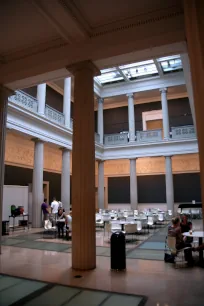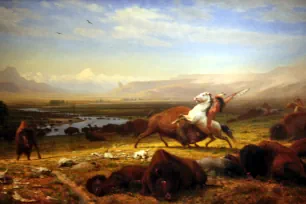The Corcoran Gallery of Art is one of the oldest art institutions in the US. The museum is best known for its fine collection of American paintings that was assembled by the founder of the museum, William Wilson Corcoran.
Unfortunately, the Corcoran Gallery of Art closed in September 2014, and its collection is now overseen by the National Gallery of Art.



Corcoran was a successful banker with a passion for art. His collection, which consisted mainly of works from American artists, quickly outgrew his mansion, so in 1859 Corcoran commissioned architect James Renwick with the construction of a dedicated gallery at the corner of Pennsylvania Avenue and 17th Street. Renwick designed a red brick building in the then popular Second Empire style. Due to the Civil War, the building was only completed in 1869. The Corcoran Gallery of Art opened its doors to the public five years later, in 1874.
In 1878 Corcoran also provided funds for the creation of an art school, the Corcoran School of Art, which opened its doors in 1890.
The Building
Corcoran continued to expand his art collection, and the original building of the Corcoran Gallery – now the Renwick gallery – soon became too small. After Corcoran’s death in 1888 a new museum building was designed by the American architect Ernest Flagg.
Flag created a massive but elegant Beaux-Arts building. The new building opened its doors in 1897 and to this day houses the Corcoran Art Gallery and the Corcoran School of Art (now the Corcoran College of Art and Design). In 1925 senator William A. Clark bequeathed his collection of European art to the Corcoran gallery, which necessitated another expansion. Architect Charles Platt built an additional wing, the Clark Wing, to house the new collection. The new wing was completed in 1928.

The building features a curving facade of white marble and pink granite. The green-colored copper roof, which was restored in 2011, has plenty of large skylights that allow natural light into the building’s spacious rooms and expansive atrium.
The exterior is decorated with copper and marble ornaments. Large lion statues guard the building’s main entrance. Inside, the atrium is surrounded with a two-story open gallery supported by columns in the Doric and, on the second floor, Corinthian order. A grand staircase, flanked with marble statues, leads to the upper floor.
The Art Collection
The first floor houses the museum’s collection of historic American and European art.



The nucleus of the American art collection was assembled by Corcoran himself, and is the museum’s forte. It shows the evolution of American painting from the eighteenth century to the mid-twentieth century, starting with realistic portraits and romanticized landscape canvases that depict idyllic scenery. Some of the highlights include the iconic portrait of George Washington by Gilbert Stuart and a landscape painting of John Singer Sargent. Later works have a more social theme and show the harsh realities of life. Some notable works here include “Smoke Hounds” by Reginald Marsh and “Into Bondage” by Aaron Douglas.
Much of the European collection stems from a 1925 bequest by William Clark, an American industrialist and senator. The collection includes works from the sixteenth to the twentieth century created by famous artists including Delacroix, Renoir, Monet, Rembrandt and Picasso.
Post-war modern and contemporary art can be found on the second floor, which also houses the museum’s collection of photographs. In addition, temporary exhibitions are also regularly held on this floor.
Salon Doré
The most impressive room in the Corcoran is the so-called Salon Doré (gilded lounge), a room that was originally part of the Hôtel de Clermont, a large mansion in Paris. It was originally commissioned in the eighteenth century by count d’Orsay as a drawing room for his future wife. In 1904 William Clark bought the whole room, including its furniture, and installed it in his new house on Fifth Avenue in New York. In 1926, it moved to the Corcoran Gallery of Art as part of Clark’s bequest to the museum.
Closure
Unfortunately, the Corcoran Gallery of Art closed in September 2014, and its collection is now overseen by the National Gallery of Art.
